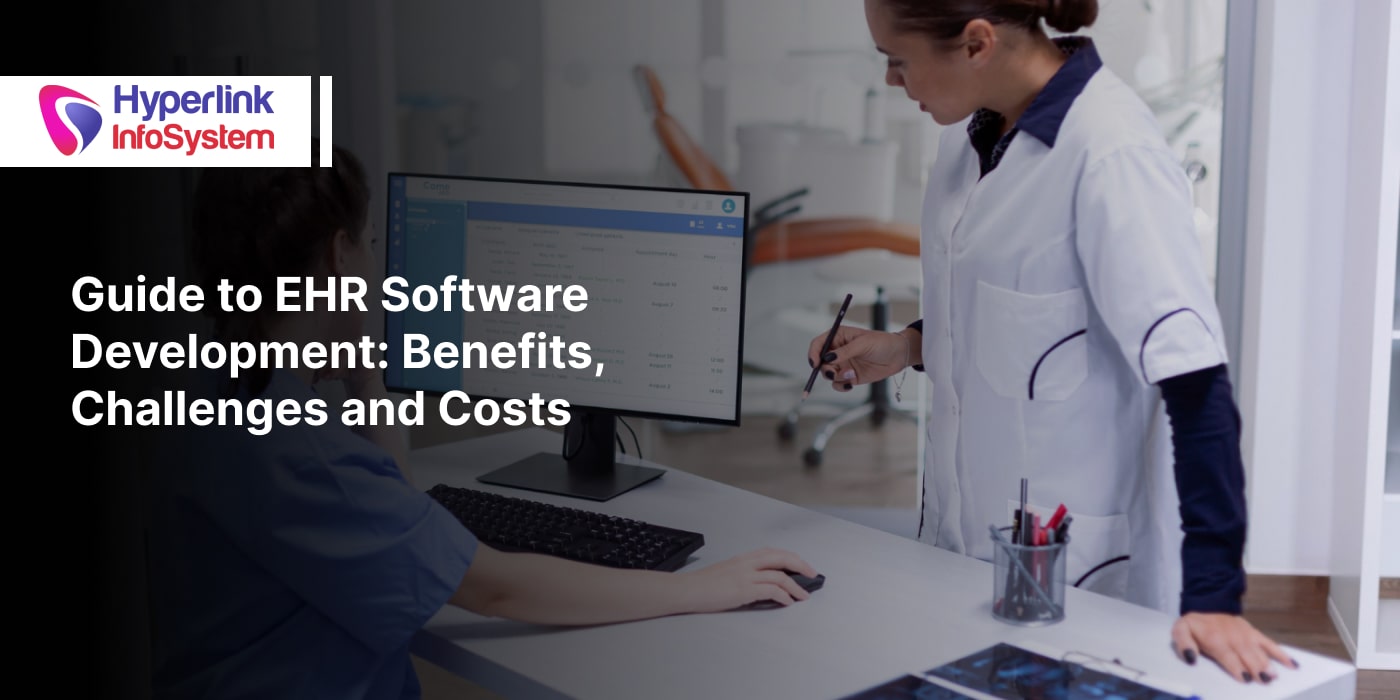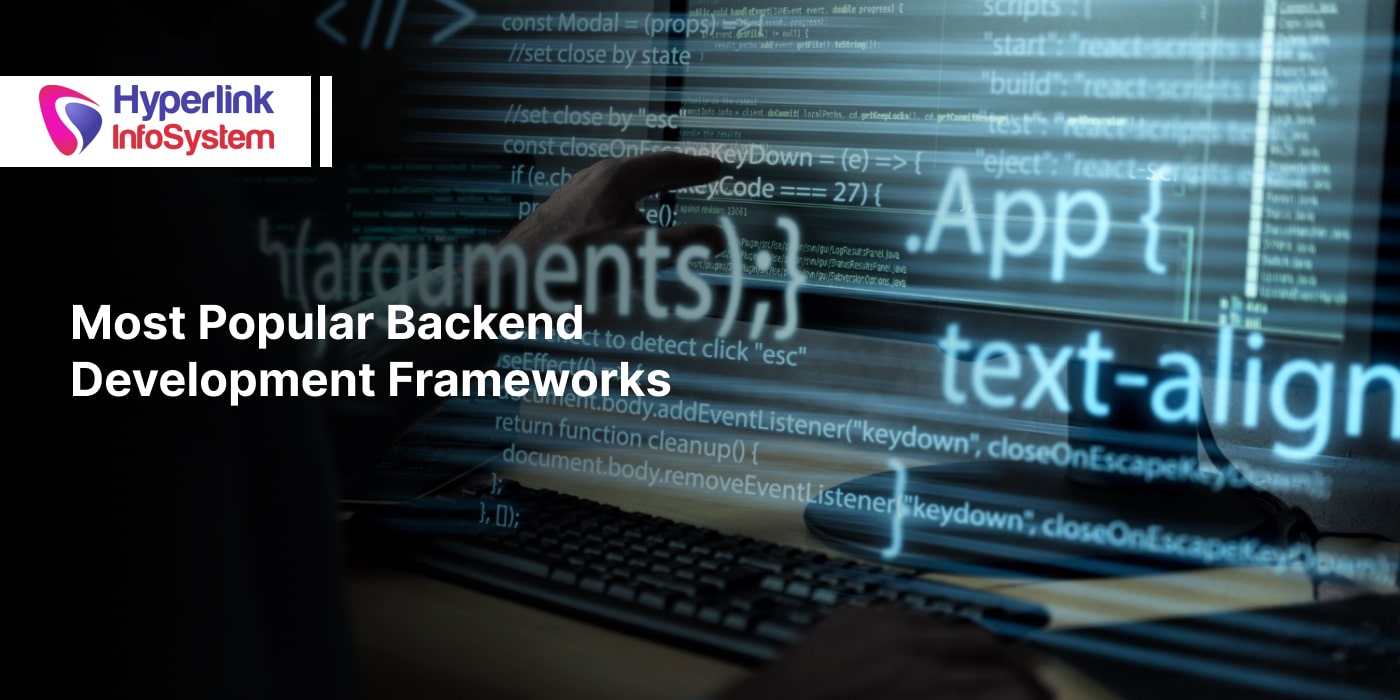Brief Guide to EHR Software Development - Benefits, Challenges and Costs
Oct 2025

Digitalization in healthcare has really picked up speed, especially after the COVID-19 pandemic. With the introduction of Electronic Health Records (EHR), the era of paper charts is finally behind us. Now that data is stored online, it’s so much easier for healthcare providers, pharmacies, patients, clinics, and others to work together and stay in sync. Despite these advancements, there have been 736 instances of data breaches in 2024 and 379 so far in 2025.
Data breaches are merely the beginning of a much larger problem. After moving to electronic health records (EHR), healthcare institutions and professionals still grapple with numerous challenges. These range from poor data sharing between EHR systems and other stakeholders to the excessive time spent on data entry, not to mention the user interface hurdles. The switch from paper to digital records can throw a wrench in workflows, and maintaining EHR systems can burn a hole in one’s pocket.
There is no denying that EHRs have transformed the healthcare landscape, but there is a vast scope for improvement. EHR is a powerful tool whose success will depend on many factors, such as the following:
- Training and proficiency in using EHR systems effectively.
- Implementing policies and standards to support data exchange and privacy.
- Workflows must be redesigned to complement EHR processes, not create hurdles.
- Degree of patient engagement with effective tool integration, allowing patient access and contribution.
In this blog, we will discuss multiple aspects related to EHR software development, benefits, challenges, and more. Let’s get started.
What Is EHR?
Not too long ago, a patient’s medical history, demographics, lab results, medication treatment, and billing/insurance-related information lay in bulky files. Transform all this information into digital files online, and you get an EHR. This may give people the impression that an EHR is merely a data storage portal or repository.
Besides facilitating seamless and quick access to information for hospitals, clinics, labs, imaging centers, patients, and others, an EHR is a tool to support the entire care-giving process. What does an EHR cover? It covers the following:
- Care Coordination - Gives healthcare providers a 360-degree picture of patients’ health.
- Clinical Decision Support - Provides alerts, reminders, and evidence-based recommendations during treatment.
- Interoperability - Smooth data exchange with labs, pharmacies, imaging centers, and other healthcare systems.
- Patient Engagement - Allows patients to view test results, progress, request refills, and message providers through secure portals.
- Analytics and Quality Improvement - Use aggregated data to identify trends, track performance, and improve public health.
The global electronic healthcare records market is estimated to be at USD 41 billion in 2025. This figure is projected to reach USD 93 billion by 2035, indicating an 8.6% CAGR during the forecast period. Digital transformation is no longer optional, especially for healthcare organizations.
The future of healthcare is all about data-driven care, where patients take an active role in their health journeys. Effective communication among all parties involved in caregiving is key, but we also need to embrace advanced technology and stay compliant with security regulations. That's where Electronic Health Records (EHR) come into play, making it easier to manage everything while reducing administrative hassles, enhancing workflows, and minimizing duplications.
What Is the Difference Between EHR and EMR?
Many individuals tend to confuse EHR with EMR. Even though Electronic Health Records and Electronic Medical Records are related, they aren’t the same thing. Both EMR and EHR are digital representations of a patient’s health information, but they differ significantly in terms of their purposes, terminology, who can access them, and what information they include. Take a look at the table below to understand the differences better.
1) What is It?
- EMR - Digital version of a patient’s chart limited to a certain doctor or healthcare facility.
- EHR - A digital and comprehensive healthcare record that holds data across multiple healthcare providers and facilities.
2) Scope
- EMR - Limited to a single clinic or practice.
- EHR - Covers multiple clinics, hospitals, labs, and specialists.
3) Data Included
- EMR - Medical and treatment history, diagnoses, prescriptions, immunizations, and lab results (from the healthcare provider only).
- EHR - EMR data plus more information from healthcare settings, imaging centers, pharmacies, and patient-generated data.
4) Interoperability
- EMR - Usually not designed to be shared with parties other than the provider or practice.
- EHR - Designed for secure sharing and interoperability across multiple healthcare systems and providers.
5) Purpose
- EMR - Primarily used by a single provider for diagnosis and treatment within their practice.
- EHR - Provides a holistic, end-to-end view of a patient’s health to multiple providers, supporting coordinated care.
6) Patient Access
- EMR - Often limited or unavailable to patients directly.
- EHR - Allows patients to access their health records via portals or apps.
7) Regulatory Emphasis
- EMR - Previously, not well-regulated regarding countrywide sharing standards.
- EHR - Meets government standards for interoperability and patient data access.
6 Main Types of EHR Systems
Below are the 6 types of EHR systems.
1) Physical-Hosted EHR
- Patient data and EHR software are stored on the servers of healthcare providers.
- This setup ensures that they have complete control over the data, but it also means they need to invest in substantial IT infrastructure, ongoing maintenance, and robust security management.
2) Remotely-Hosted EHR
- EHR is hosted on external services, eliminating the need for in-house IT resources.
- Sub-categories of remotely hosted EHRs include ASP, shared, and dedicated hosting.
3) Cloud-Based EHR
- Everything is hosted in the cloud, allowing healthcare providers to access it from any internet-enabled device.
- This setup comes with lower upfront costs, automatic updates, and scalability, but it does need a reliable internet connection and demands that healthcare providers trust the vendor's security.
4) Open-Source EHR
- Since EHRs are open-source, healthcare providers and third parties can easily tailor them to their needs.
- While this can lead to lower licensing costs, it does mean that you'll need skilled developers to handle the implementation and ongoing maintenance.
5) Speciality-Specific EHR
- Suited for specific medical fields such as pediatrics, oncology, and cardiology.
- Offers workflows, templates, and tools specifically for such niche medical fields.
6) Integrated EHR/Practice Management System
- Think of an Integrated EHR as a blend of patient records and key practice management features, including billing, scheduling, and insurance claims processing.
- Perfect for streamlining administrative and clinical operations.
Besides the above, there are other types of EHR systems, such as hybrid, standalone, dedicated, and subsidized systems. Healthcare organizations must choose the right type of EHR based on their requirements, budget, infrastructure, and documentation needs. Consult a reputed EHR software development company for tailored implementation and maintenance.
Pros and Cons of EHR Systems
Like every software or platform, EHR systems have their pros and cons. Below are the pros and cons of EHR systems.
Pros
- Improved Accessibility - Authorized staff can access patient records from any location, improving care coordination.
- Better Care Quality - Provides a 360-degree view of patient history, allergies, and treatments, reducing medical errors.
- Data Centralization - Consolidates lab results, imaging, prescriptions, and notes in a single location.
- Enhanced Communication - Facilitates secure data sharing between providers, specialists, and patients.
- Decision Support Tools - Sends alerts for drug interactions, reminders for preventive care, and evidence-based recommendations.
- Regulatory Compliance - Supports adherence to healthcare regulations like HIPAA.
- Patient Engagement - Many EHRs have portals allowing patients to view test results, request refills, or message providers.
- Long-Term Cost Savings - Reduces dependence on physical records, storage, and transcription costs over time.
Cons
- High Implementation Costs - Software licenses, hardware, and staff training can be expensive.
- Learning Curve - Staff may need considerable time to adapt to new systems.
- Technical Issues - System downtime, bugs, or sluggish performance can disrupt patient care.
- Privacy & Security Risks - Vulnerable to hacking, unauthorized access, or data breaches.
- Workflow Disruption - May require changes to established clinical processes.
- Data Entry Burden - Excessive documentation requirements may result in clinician burnout.
- Interoperability Issues - Difficulty integrating with other EHR systems or legacy software.
- Upgrades & Maintenance - Requires ongoing updates, support, and technical expertise.
Is implementing EHR the right decision for your business? It can be difficult for healthcare professionals and organizations to decide. Consult a professional healthcare software development company for clarity regarding implementation and choosing the right features.
10 Key Features to Include in an EHR System
Below are 10 key features every EHR system must have in the current era.
1) Interoperability & Data Exchange
- Standards-First APIs - Real-time read/write access across hospitals, labs, pharmacies, telehealth vendors, and payers.
- Open Integration Layer/API Gateway - With this standard API, external systems and apps can seamlessly connect to the EHR, allowing for the addition or removal of features. This helps to lessen the reliance on a single vendor.
- Two-Way Data Flow - Enables EHR to send and receive complete patient health data with multiple systems/parties while obtaining patient permission.
2) Patient-Centric Functionality
Modern Patient Portal With Mobile App - Includes appointments, televisits, and secure messaging.
Self-Service Capabilities - The platform provides a range of self-service features for users, including online scheduling, digital check-ins, insurance validation, online payments, and plan management, along with helpful scheduled reminders.
Patient-Reported Outcomes, Remote Monitoring & Device Integration - Includes wearables, home blood pressure/glucometers with real-time alerts to clinicians.
3) Clinical Workflow and Decision Support
AI-Assisted Charting & Clinical Documentation - Structured templates and NLP features analyze clinicians' voice notes/text and convert them into structured entries. This ensures that they type and click less.
Contextual Clinical Decision Support (CDS) - Safety alerts, dosing checks, guideline-based recommendations, and predictive risk scores.
Customizable Specialty Templates and Order Sets - In departments like ED and behavioral health, clinicians benefit from ready-made templates and pre-defined orders. This makes it easier for them to treat patients and record their diagnoses with just a few clicks.
4) Revenue/Business Operations
End-to-End Revenue Cycle Management (RCM) Integration - Streamlining the insurance payment process involves a few key tasks, such as verifying patient coverage, recommending the appropriate medical billing codes, resolving denied claims, and overseeing patient payments.
Prior Authorization Automation - By connecting EHRs with insurance companies, healthcare organizations can streamline the process of requesting, tracking, and receiving medical services. This means faster approvals and less time spent on manual work.
Flexible Pricing & Billing UI - Linking EHR with RCM improves cash flow, reduces billing errors, and time spent on administrative tasks.
5)Analytics and Population Health
Real-Time Dashboards - Live, visual reports to track KPIs across patient care, finances, and operations, which help identify issues followed by corrective actions.
Population Health Modules - These health modules are designed to keep track of patient groups by pinpointing care gaps and monitoring chronic conditions, all while taking into account the socio-environmental factors that can affect health.
Embedded & Regulatory Reporting - With this feature, EHRs can effortlessly monitor and produce customized healthcare quality reports, such as HEDIS or MIPS. Plus, it streamlines the process of exporting these reports in the right format for submission to the relevant authorities.
6) Security, Compliance & Resilience
Enterprise Security Controls - Implementing robust security and compliance measures is key to managing patient data access, tracking activities, and encrypting information while it's stored and transferred.
Vendor and BA oversight, incident response, business continuity, backups, and offline access.
Evolving Regulations - Stay updated and get ready for the latest proposed HIPAA changes, which include mandatory multi-factor authentication, asset tracking, vendor breach notifications, and regular security audits. These updates will hold healthcare providers and tech vendors to a higher standard of accountability.
7) Usability, Human Factors & Clinician Experience
Fast, Low-Click UI - Create the EHR in a way that allows users to see only the relevant tools with just a few clicks. The layout should be compatible with all digital devices, such as laptops, tablets, and smartphones, ensuring a seamless experience.
User Configurable Workflows - Allows users to personalize their EHR screens, forms, and shortcuts so they can work in a way that suits them best. On top of that, the built-in guides and tips make it easy to pick things up and get used to the system.
Clinician-Facing Automation - Explore cutting-edge features that effortlessly populate information, recommend common choices, and streamline task batching. This approach minimizes staff burnout and frees up more time for focusing on patient care.
8) Extensibility & Vendor Strategy
App Marketplace/Developer Ecosystem - Think about EHR systems equipped with a built-in app store where third-party developers can showcase and sell add-on tools that connect with the system using APIs.
Data Portability and Migration Tools - Valuable tools that allow EHR users to export complete patient data and records securely when switching systems and vendors.
Flexible Deployment - Users have the flexibility to select from cloud, hybrid, and on-premises deployment models, all backed by straightforward service guarantees and upgrade timelines.
9) Patient Trust & Equity
Transparent Consent & Data Sharing Controls - Provide patients with simple, easy-to-use tools to control data viewing, sharing, and use for purposes such as family access or medical research.
Multi-Language Support, Accessibility, and Mobile-Focused Approach - Creating an EHR that allows individuals with varying language skills, technical know-how, and internet access to easily use it across different devices is essential.
Capture SDOH & Support Tailored Outreach - EHR systems document patients' social and economic circumstances, which allows healthcare organizations to provide customized support services and resources.
10) Operational Features Driving ROI and Adoption
Implementation Playbook, Training & 24/7 Support - Have a clear step-by-step plan, provide adequate staff training, and ensure 24/7/365 help to ensure EHR works smoothly.
Performance and SLAs - Setting clear speed and reliable targets for EHR while adding new features gradually to reduce risks and disruptions.
Safety Tracking and Usability - Continuously tracking to assess the EHR’s care quality and usability after launch. Also, get quick feedback from frontline users to fix issues quickly.
Including the right features for your healthcare business is crucial to ensuring profitability, long-term success, and patient satisfaction. Contact a reputed custom software development company for more information.
Tech Stack Required for EHR Software Development
Developing an EHR software requires a very niche tech stack and skill sets to balance high performance, regulatory compliance, security, and interoperability with other healthcare systems. Below is a brief explanation of the tech stack for a healthcare app.
1) Front-End (User Interface)
Languages and Frameworks
- React.js or Angular for dynamic, component-based UIs.
- Vue.js - Perfect lightweight alternative for smaller projects.
UI Libraries/Design Systems
- Material UI, Ant Design, and Tailwind CSS for consistent and responsive design.
Data Visualization
- D3.js, Chart.js, or Recharts for analytics dashboards and patient trends.
2) Backend
Languages and Frameworks
- Node.js (Express.js, Nest.js) - scalable and event-driven.
- Java (Spring Boot) - Strong for enterprise-grade healthcare apps.
- .NET Core - Favored in the healthcare sector due to Microsoft’s ecosystem.
- Python (Django and FastAPI) - Great for rapid development and ideal for AI modules.
API Protocols
- FHIR (Fast Healthcare Interoperability Resources) - For seamless and secure healthcare data exchange.
- HL7 v2/v3 for efficient legacy system integration.
- REST & GraphQL for modern API communication.
3) Database Layer
Relational Databases
- PostgreSQL, MySQL, MS SQL Serves - Stores patient data in a pre-defined, organized format for easy searching, sorting, analysis, and transfer.
NoSQL Databases
- MongoDB - Provides flexible storage for unstructured medical notes.
Specialized Healthcare Data Stores
- OpenEHR-Compliant Databases - These databases adhere to the openEHR standard, which is a globally accepted/structured way to store and share healthcare data across multiple systems without compromising security.
4) Cloud & Hosting
Cloud Hosting
- AWS (HIPAA-Eligible Services) such as Azure Health Data Services and Google Cloud Healthcare API.
Containerization & Orchestration
- Docker, Kubernetes for scalable microservices deployment.
Serverless Options
- AWS Lambda/Azure Functions for event-driven healthcare tasks.
5) Security and Compliance
Encryption
- AES-256, TLS 1.3 for data at rest and in transit.
Identify and Access Management
- OAuth 2.0, OpenID Connect, SAML.
Auditing and Logging
- ELK Stack (Elasticsearch, Logstash, Kibana), AWS CloudTrail.
6) Interoperability and Healthcare-Focused Tools
- HL7/FHIR SDKs such as HAPI FHIR (Java) and Smile CDR.
- PACS Integration - DICOM standards for medical images.
- E-Prescription APIs - Examples include Surescripts and DrFirst.
7) DevOps & CI/CD
CI/CD Tools
- GitHub Actions, GitLab CI, and Jenkins
Testing
- Selenium, Cypress (UI), Postman/Newman (API), JMeter (performance).
Infrastructure as Code
- Terraform and Ansible
Are you thinking of building an in-house team for your next EHR software development project? Consider hiring dedicated software developers with the relevant experience and knowledge to handle the project from start to finish.
Technical Skills Required for EHR Software Development
Besides hiring professionals with proficiency in backend and frontend development, database, cloud hosting, and others, technical knowledge is also crucial. Below are the technical skills required to ensure top-notch EHR software development.
Healthcare Domain Knowledge
- Requires a thorough understanding of EHR workflows, patient registration, clinical documentation, lab results, and prescriptions.
- Must know regulations in different geographical regions. This includes HIPAA (USA), GDPR (EU), and PIPEDA (Canada).
- Complete understanding of medical coding systems such as ICD-10, CPT, and SNOMED CT.
Software Development Skills
- Proficiency in the relevant frontend and backend languages for the project.
- API development and integration (REST, GraphQL, and FHIR).
- Database schema design for healthcare data.
- Scalability and performance optimization.
Security & Compliance Skills
- Implementing role-based access control.
- Secure authentication and authorization.
- Data encryption and anonymization techniques.
- Penetration testing and vulnerability scanning.
Interoperability Skills
- Working with HL7/FHIR data formats (JSON, XML).
- Integration with hospital systems such as LIS, RIS, and HIS.
- Handling PACS/DICOM for imaging.
DevOps and Deployment Skills
- CI/CD pipeline creation.
- Container orchestration (Kubernetes).
- Monitoring and logging healthcare-grade systems.
Don’t forget to assess the above technical skills in individuals while hiring software developers for EHR development. When hiring developers or building an in-house team for EHR software development, assessing candidates for the above skills ensures that the team delivers a secure, compliant, interoperable, and high-performance EHR system. At the same time, this approach carries risks, enhances patient care, and reduces the need to write code repeatedly.
Challenges Faced During EHR Software Development
Below are the challenges that healthcare companies face during EHR software development.
- Data Security and Privacy - Use HIPAA-compliant encryption, access controls, and regular security audits.
- Interoperability - Implement HL7/FHIR standards for smooth data exchange across systems.
- Adoption Resistance - Provide in-depth, intuitive UI/UX, and comprehensive staff training.
- Data Migration Issues - Use automated ETL tools with validation checks to ensure accuracy.
- Regulatory Compliance - Update EHR system features to ensure compliance with ever-changing healthcare regulations.
- Scalability - Design with modular architecture and cloud-based infrastructure.
- High Development Costs - Use agile development and open-source components wherever possible.
- Downtime and Reliability - Implement redundant servers and disaster recovery protocols.
- Legacy System Integration - Build custom APIs and middleware for compatibility.
- Complex Workflow Customization - Offer configurable templates and role-based features.
Estimated Costs for EHR Software Development
Below are the estimated costs for EHR software development filtered by complexity, individual components, and ongoing costs.
|
Organization Type |
Estimated Costs (USD) |
Key Features |
|
Small Practices/Startups |
$30,000 - $150,000 |
Basic functionality (patient records, scheduling) |
|
Small Practices & Startups - Full-featured |
$75,000 - $250,000 |
Workflows, documentation, compliance |
|
Medium-Scale (Multi-Location Clinics) |
$150,000 - $500,000 |
Advanced reporting, patient portals, system integration |
|
Enterprise-Level (Hospitals or Large Networks) |
$500,000 - $2,000,000+ |
Epic-like systems with decision support, analytics, interoperability |
|
Alternative EHRs Similar to Epic |
$12,000 - $210,000 |
Scalable builds; compliance, AI features & integrations can raise costs by 1.5 to 2 times. Extra $20,000–$50,000 for regulatory readiness; hidden costs add 10–18%. |
Stage-Wise Costs of EHR Software Development
|
Development Stage |
Estimated Costs (USD) |
|
Development and Planning |
$5,000 - $10,000 |
|
UI/UX Design |
$4,000 - $12,000 |
|
Architecture & Tech Setup |
$5,000 - $10,000 |
|
Core Development |
$30,000 - $90,000+ |
|
API & Integration |
$10,000 - $40,000+ |
|
Security & Compliance |
$4,000 - $15,000 |
|
Testing and QA |
$10,000 - $40,000 |
|
Certification |
$20,000 - $60,000 |
|
Deployment & DevOps |
$8,000 - $20,000 |
|
Training & Documentation |
$5,000 - $15,000 |
|
Post-Launch Support & Maintenance |
$25,000 - $90,000/year |
Below are the percentage-wise costs for each stage.
- Requirements & Planning: 10 - 15%
- Design: 10 - 20%
- Core Development: 25 - 35%
- Database Development: 10 - 15%
- Security & Compliance: 15–20%
- Integration: 10–15%
- Testing & QA: 5–10%
- Deployment: 5–10%
- Maintenance & Support: 10–15%
Ongoing and Hidden Costs of EHR Software Development
Below are the ongoing and hidden costs of EHR software development.
|
Cost Type |
Costs in USD |
Additional Notes |
|
First-Year Maintenance |
Upto $90,000 |
Medium-sized organizations |
|
Annual Maintenance |
15–25% of the initial development cost |
Covers updates, support, and infrastructure |
|
Cloud-based Licensing |
$1,200 - $3,500/user/year |
Small practices - $1,200/user/year Large systems up to $3,500/user/year |
|
Additional Implementation (Small Businesses) |
$20,000 - $65,000 |
Total setup and configuration |
|
Additional Implementation (Mid-Sized Companies) |
$65,000 - $200,000 |
Includes workflow integration |
|
Additional Implementation (Large Enterprises) |
$650,000 - millions |
Depends on complexity and scale |
|
Migration Costs |
$50,000 - $250,000 |
Data transfer and setup |
|
Legacy System Upgrades |
$2M to $4M |
Complex integrations and modernization |
These figures are just to give companies an approximate idea of EHR software development costs. For an accurate estimate, it is advisable to consult a professional healthcare software development company.
Conclusion
EHR software development can be complicated. This may tempt many healthcare providers and practitioners to opt for a generic EHR, which can prove to be disastrous. Although they may seem cost-effective at first, implementation can be challenging, and premium features may incur additional costs. Also, a generic EHR may not be ideal for scaling and managing increased business demands.
Custom EHR software development is perfect for most healthcare providers. It will help them meet business needs while ensuring top-notch security and enhancing patient satisfaction. However, hiring developers and getting into the technicalities of EHR software development can be overwhelming for many. Hyperlink InfoSystem is here to help. With 12+ years of industry experience, 3000+ completed projects in the past decade, and a large fleet of technical experts, we can take on any project, regardless of complexity. Speak to one of our experts to know more.
Schedule a Consultation Today!
Frequently Asked Questions
Ongoing costs after EHR software development include maintenance, updates, hosting, security monitoring, compliance checks, and user support.
Companies are advised to apply security patches without any delay, implement them as soon as they are released. Major security updates should be done every 6 to 12 months.
Future trends in EHR software development include AI-driven automation, improved interoperability through FHIR, patient-centric design, and integration with health tech wearables.
EHR systems with scalable architecture allow companies to add more users, clinics, or integrated services without sacrificing performance or downtime.
It is possible to upgrade or modernize legacy systems through migration, API integration, and UI/UX redesign while retaining existing patient data. The costs can vary. For small to medium-sized enterprises, these costs can be approximately $50,0000 to $150,000. In contrast, the modernization costs for large enterprise-grade systems can range from $200,000 to $500,000 or more.
Latest Blogs

Is BlockChain Technology Worth The H ...
Unfolds The Revolutionary & Versatility Of Blockchain Technology ...


IoT Technology - A Future In Making ...
Everything You Need To Know About IoT Technology ...

Feel Free to Contact Us!
We would be happy to hear from you, please fill in the form below or mail us your requirements on info@hyperlinkinfosystem.com
Hyperlink InfoSystem Bring Transformation For Global Businesses
Starting from listening to your business problems to delivering accurate solutions; we make sure to follow industry-specific standards and combine them with our technical knowledge, development expertise, and extensive research.
4500+
Apps Developed
1200+
Developers
2200+
Websites Designed
140+
Games Developed
120+
AI & IoT Solutions
2700+
Happy Clients
120+
Salesforce Solutions

40+
Data Science

















